Abstract
In this study, for restoration of ecological systems in buildings, porous vegetation red clay green roof blocks were designed for performance evaluation. Blast furnace slag (BFS; fine aggregates (agg.)), coarse aggregates, polyvinyl alcohol (PVA) fiber (hydrophilic fiber), and red clay (ecofriendly additive material) were applied to the construction of the porous vegetation red clay green roof blocks. A decrease in cement use is one way of reducing carbon emissions. To increase the water retentivity and the efficiency of roof vegetation blocks, blast furnace slag aggregates with excellent water absorptivity and polyvinyl alcohol fiber with a water absorption rate above 20% were added. In particular, the addition of polyvinyl alcohol fiber prevents performance reduction of the green roof vegetation blocks during freezing and melting in winter. Compressive strength, void ratio, and unit-mass tests were conducted to evaluate the performance of the roof vegetation blocks. After their application to roof vegetation, the effect of water purification was evaluated. According to the experimental results, the mix that satisfies the target performance of green roof vegetation blocks (compression strength above 8 MPa, void ratio above 20%, unit mass 2.0 kg/cm3 or below) is: cement = 128.95 kg/m3, BFS = 96.75 kg/m3, red clay = 96.75 kg/m3, water = 81.50 kg/m3, BFS agg. = 1450 kg/m3, PVA fiber = 1.26 kg/m3. The green roof vegetation blocks were designed using the mix that satisfied the target performance. To find the amount of attainable water due to rainfall, a rainfall meter was installed after application of the roof vegetation to measure daily rainfall and calculate the amount of attainable water. The results show that, for 1 mm of rainfall, it is possible to attain about 0.53 L of water per 1 m2. In addition, the water quality of effluents after application of roof vegetation was analyzed, and the results satisfied Class 4 of the River-life Environmental Standard for Availability of Agricultural Water.
1. Introduction
In recent years, there has been significant destruction of the natural environment due to rapid industrialization and urbanization [1,2]. It is desirable to construct an environment or space where nature and mankind coexist, namely, a green space [3,4,5]. However, it is very difficult to secure such spaces, so an alternative is to expand green spaces by utilizing roofs of buildings and houses as artificial grounds for use as green spaces [1,2]. Roof vegetation requires the creation of artificial conditions similar to those of natural ground, spatially separated from natural ground [5,6,7]. Thus, since roof vegetation is undertaken in non-natural environments, a variety of supplemental methods are required during vegetation to grow plants and provide effective/continuous maintenance and management [8,9,10]. The features of such roof vegetation schemes are the restoration of soil ecosystems [1,2]. The relaxation of urban heat intensification may also result from roof vegetation. Thermal image analysis of actual summer surface temperatures has shown that the temperature of green areas is significantly lower than that of paved areas, and the daily temperature range is also lower in green areas [7,8,9,10,11]. This indicates that the evapotranspiration of solar radiation in green areas can alleviate the phenomenon of the development of heat islands in urban or industrialized areas [7,8,9,10,11]. In addition, roof vegetation can have an impact on urban flood prevention and air purification [7,8,9,10,11]. Roof vegetation is known to absorb carbon dioxide, nitrogen compounds, benzene, dust, and heavy metals, and emit oxygen to purify air [7,8,9,10,11]. Roof vegetation can also affect water purification; fine dust in the air can mix with initial rainwater and flow out rapidly, causing severe problems such as river pollution; however, roof vegetation can filter water through soil layers and reduce water pollution [7,8,9,10,11]. Also, the roof vegetation has many other advantages, such as noise reduction and improvement of the urban scenery [7,8,9,10,11]. However, despite such advantages, current roof vegetation methods have a range of problems [8,11]. The most basic and important factor for roof vegetation is securing soil layers, the base for the growth and development of plants [8,11]. Since, in the conventional construction method, buildings and planting are treated separately, the soil required for planting is usually constructed by mounding on the rooftop; however, this increases the load on buildings [8,11]. To improve on this method, studies and developments on roof vegetation have mainly focused on the weight reduction of permeable layers and soil [8,11]. Recently, porous vegetation concrete has become ecofriendly, since it reduces CO2 emissions from cement production by replacing some cement with blast furnace slag fine powder and red clay, thereby recycling industrial byproducts [12,13,14,15,16,17,18]. The vegetation concrete is a porous material that encourages the growth of plants by introducing nutrient-containing water into voids [12,13,14,15,16,17,18]. Due to soil compartments on the porous concrete surfaces, there is space for germination, drying, and even fertilizer supplies after plant germination [12,13,14,15,16,17,18]. The use of porous vegetation concrete is depicted in Figure 1. The required properties of vegetation concrete are that plants can grow inside the concrete in accordance with the basic mechanical properties of concrete [12,13,14,15,16,17,18].
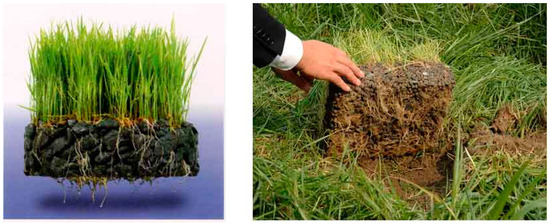
Figure 1.
Photo of porous vegetation concrete blocks.
In addition, coarse aggregates may also be replaced with blast furnace slag aggregates. Blast furnace slag aggregates have a high moisture absorption rate and a high surface void ratio [9,15,16]. This study evaluated the use of concrete vegetation blocks and direct application of artificial vegetation soil. Porous concrete vegetation blocks do not require the installation of drainage pipes and can also reduce the amount of vegetation soil that is mounded, solving problems relating to permeability and soil weight reduction. Especially, in this study, we tried to improve the performance of porous concrete by applying recycled materials, red clay, and fiber reinforcement. However, there are not many studies applying the existing porous concrete to rooftop greening. Therefore, in this study, the physical and mechanical properties of green roof vegetation blocks made using blast furnace slag coarse aggregates, blast furnace slag fine powder, red clay, and polyvinyl alcohol fiber are evaluated. This study also investigated water quality in a vegetated roof.
2. Experimental Design
In this study, compression strength, void ratio, and unit-mass tests were conducted on green roof vegetation concrete made using blast furnace slag coarse aggregates (lightweight aggregates), polyvinyl alcohol fiber (hydrophilic fiber), and red clay (eco-friendly additive). Blast furnace slag aggregates with a high moisture absorption rate and polyvinyl alcohol fibers with a water absorption rate above 20% were used to increase the water retentivity of the green roof vegetation blocks.
2.1. Materials
ASTM Type 1 cement (Sungshin Cement Co., Ltd., Seoul, Korea), calcined red clay, polyvinyl alcohol (PVA) fiber (Nycontech Co., Ltd., Seoul, Korea), blast furnace slag coarse aggregates (Hyundai-steel Co., Ltd., Dangjin, Korea), and blast furnace slag (BFS) fine powder (Sungshin Cement Co., Ltd., Seoul, Korea) were used, and the properties of the red clay, blast furnace slag, and blast furnace slag aggregates are given in Table 1, Table 2 and Table 3, respectively (characteristics supplied by the manufacturer). The blast furnace slag aggregates used in this study are shown in Figure 2. In addition, as a hydrophilic fiber, PVA fiber, which exhibits excellent adhesion to concrete due to hydroxyl radicals on the surface, was used. The physical and mechanical properties of the PVA fiber are given in Table 4 (characteristics supplied by the manufacturer), and the shape is shown in Figure 3.

Table 1.
Composition of red clay (Unit: wt %).

Table 2.
Composition of blast furnace slag (BFS) (Unit: wt %).

Table 3.
Physical properties of blast furnace slag coarse aggregate (agg.).
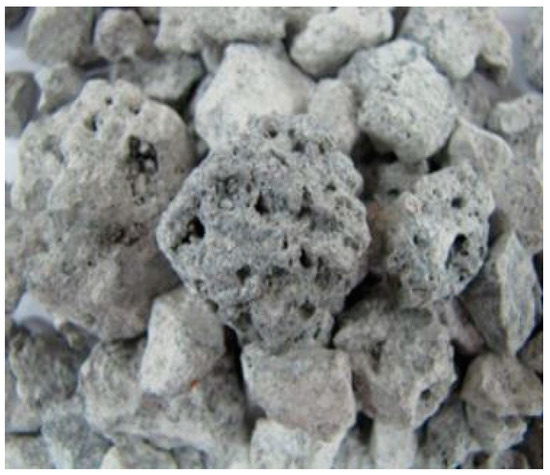
Figure 2.
Photo of blast furnace slag aggregates.

Table 4.
Physical and mechanical properties of polyvinyl alcohol (PVA) fiber.
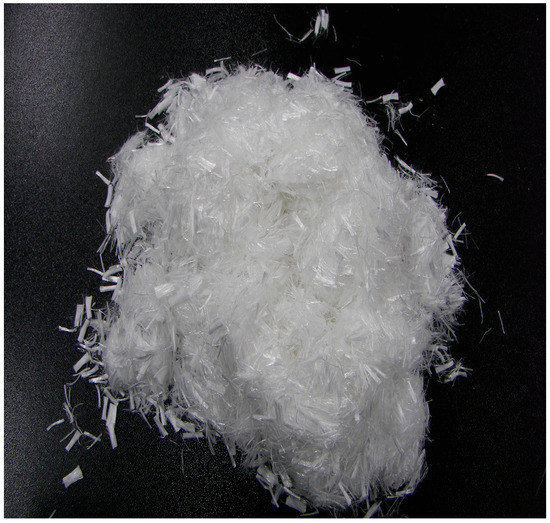
Figure 3.
Photo of PVA fiber.
2.2. Mix Proportions
Blast furnace slag aggregates with a maximum size of 25 mm were used. Considering the environmental and economical aspects, a certain amount of cement in the green roof vegetation concrete was replaced with blast furnace slag fine powder and red clay to minimize the amount of cement used. The target performance was set to a compressive strength of 8 MPa or higher, void ratio of 20% or higher, and unit mass 2.0 kg/cm3 or below. In general, the target compressive strength and porosity of the vegetation concrete applied to the stream slope reinforcement method are 10 MPa or more and the porosity is 20% or more, respectively [19,20]. However, this study aims to apply lightweight concrete to rooftop greening. Lightweight concrete has a reduced compressive strength compared with normal weight concrete. Therefore, the target compressive strength was set to 8 MPa. However, void ratio was determined to be more than 20%, which is the standard of vegetable concrete, to improve vegetation. In addition, to obtain light weight, we set a target of less than 2.0 kg/m3 of unit mass, which is a lightweight concrete standard [21,22]. Table 5 shows the mixing ratios applied in this study. Blast furnace slag fine powder was used to replace 0% and 30% of cement weight, and red clay 0%, 10%, and 20% of cement weight. A volumetric ratio of 0.2% of PVA fiber was applied. A naphthalene-based plasticizer was applied to maintain fluidity during mixing. A naphthalene-based plasticizer used 0.2% of binder (cement + BFS + red clay) weight.

Table 5.
Mix proportion of green roof blocks.
2.3. Test Methods
2.3.1. Void Ratio
To measure the void ratio of the fiber-reinforced porous red clay roof vegetation concrete, test specimens with a diameter of 100 mm and a height of 200 mm were tested in compliance with the volumetric method of the porous concrete void ratio test methods of the previous research [9,15,16,17,18]; the void ratio was calculated after 28 days of curing using Equation (1).
where W1 and W2 are the underwater and air-dried weights of the specimen, respectively, and V is the volume of the specimen.
2.3.2. Unit Mass
Measurement of the unit volumetric weight for the green roof vegetation concrete was conducted according to the unit-mass test method of KS F 2462 Structure Light Weight Concrete [22].
2.3.3. Compressive Strength
To evaluate the strength properties of the green roof vegetation concrete, a compression strength test was conducted according to KSF 2405 [23]. For the experiment, specimens with a diameter of 100 mm and a height of 200 mm were fabricated, initially cured at a temperature of 23 ± 2 °C and relative humidity of about 58% for 24 h, removed to conduct water curing for 28 days, and then the compressive strength was measured.
3. Results and Discussion
3.1. Void Ratio
The green roof vegetation concrete has pores to support the growth and development of plants; hence, its void ratio is an important characteristic. In this study, the effects of blast furnace slag, red clay, and hydrophilic polyvinyl alcohol fiber on the void ratio of the green roof vegetation blocks were evaluated. The results of the void ratio test are shown in Figure 4. This indicates that the hydrophilic PVA fiber absorbs mixing water and prevents the red clay binder from flowing down and filling pores. The results for the void ratio test with different substitution proportions of blast furnace slag show an increase in void ratio with increasing proportions of blast furnace slag. The results for the void ratio test with different substitution proportions of red clay show that substitution by red clay increases the void ratio up to a certain amount, after which the void ratio decreases. The void ratio test results indicate that the simultaneous use of blast furnace slag and red clay is most effective, given that a void ratio above 20% is necessary for vegetation. In particular, the addition of PVA fiber in the No. 3, No. 6, and No. 8 mixes appears to provide suitable conditions.
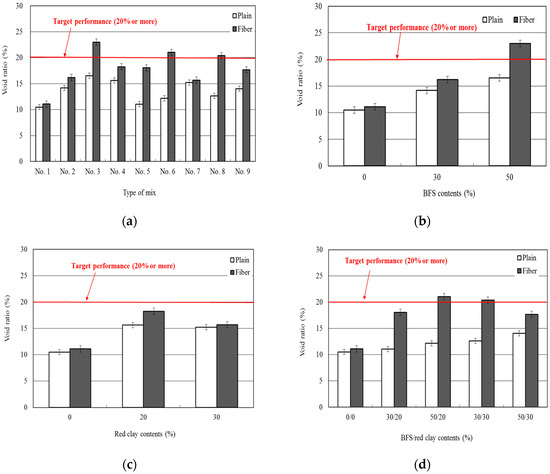
Figure 4.
Void ratio test results of porous vegetation red clay green roof concrete. (a) PVA fiber content; (b) BFS content; (c) red clay contents; (d) BFS and red clay contents.
3.2. Unit Mass
It is important that the green roof vegetation concrete weight does not affect architectural structures. It is recommended that the weight be as low as possible by using lightweight aggregates. In this study, the unit mass for each mix of the green roof vegetation concrete was measured. The test was conducted according to the unit-mass test method of KS F 2462 [19] for structural light weight concrete, and the test results are shown in Figure 5. The test results show that the unit mass of the green roof vegetation concrete is below 2.0 kg/m3. The test results show that the target performance of this study was to achieve a unit weight of 2.0 kg/m3 in all mix proportions. This unit mass is in the range of lightweight concrete and is lower than target performance. The addition of fiber did not have a significant influence on the unit mass of the green roof vegetation blocks. The fiber has a low specific gravity and it only forms around 1% of the total mix; thus, the addition of fibers did not change the unit mass significantly. The results for the unit mass test with different substitution proportions of blast furnace slag show that, as the substitution rate of blast furnace slag increases, the unit mass decreases because the density of blast furnace slag is smaller than that of cement. In addition, an increase in the substitution rate of red clay decreases the use of cement, which reduces the unit mass, since the density of red clay is lower than that of cement. The results for the unit mass test with different substitution proportions of blast furnace slag aggregates and red clay show that almost no significant effects are observed, but as the substitution rate increases, the unit mass decreases by a small amount. The results of the unit mass test on all mixes show that, since all mixes give similar results, they are all satisfactory for use as green roof vegetation blocks.

Figure 5.
Unit-mass results of porous vegetation red clay green roof concrete. (a) PVA fiber content; (b) BFS content; (c) red clay contents; (d) BFS and red clay contents.
3.3. Compressive Strength
In this study, compressive strength tests were conducted based on different substitution proportions of blast furnace slag and red clay, and the addition of reinforcing fiber. The results for the compressive strength tests at a material age of 28 days are shown in Figure 6. The results for the compressive strength test with the addition of polyvinyl alcohol fiber show that the strength was higher than when the fiber was added, showing that the fiber suppresses the destruction of the porous red clay concrete through its crosslinking action. In particular, polyvinyl alcohol fiber increased the compressive strength by creating excellent adhesion through its hydrophilicity. The results for the compressive strength test with different substitution proportions of blast furnace slag show that the strength decreases as the substitution rate increases. The results show that no significant extra strength is generated up to a material age of 28 days because the substitution rate of blast furnace slag is relatively large (25% and 50%), and the slag delays the generation of hydration heat through a quasi-pozzolanic reaction. The results for the compressive strength test with different substitution rates of red clay show that the strength did not change significantly up to mix No. 4 containing 64.50 kg/m3 of red clay, but further increases in the substitution proportion (up to 96.75 kg/m3) caused a greater decrease in strength. The results for the compressive strength test with different substitution proportions of blast furnace slag and red clay show that when the substitution of red clay increased at the same rate as that of blast furnace slag, the decrease in strength was not great; however, when the amount of blast furnace slag increased at the same substitution rate as that of red clay, a relatively large strength decrease was observed. Thus, the substitution rate of blast furnace slag had a greater influence on the strength. The mixes that satisfied the target compressive strength of 8 MPa were No. 1, No. 2, No. 3 (fiber), No. 4, No. 5 (fiber), No. 7, and No. 8 (fiber).
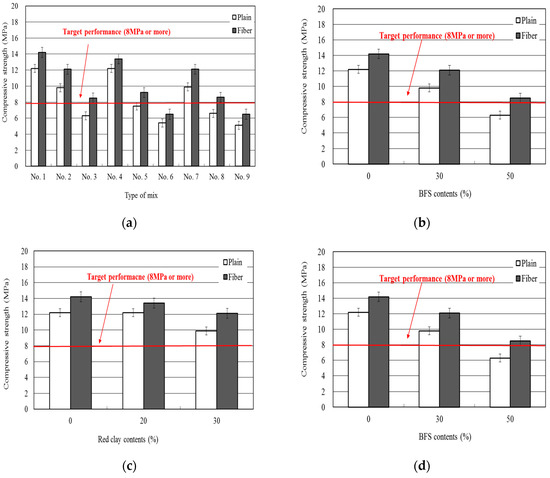
Figure 6.
Compressive strength test results of porous vegetation red clay green roof concrete. (a) PVA fiber content; (b) BFS content; (c) red clay content; (d) BFS and red clay contents.
4. Field Application
4.1. Manufacturing of Green Roof Blocks
The analyzed green roof vegetation blocks were designed and fabricated with the following dimensions: 250 × 200 × 80 mm. Table 6 and Figure 7 show the data, design drawing, and shape of the green roof vegetation blocks. The indoor test results showed that the mix that satisfied the target values and maximum use of byproduct materials (economy and environment) for green roof vegetation blocks for roof vegetation was mix No. 8 with fiber addition; thus, in this study, test products were fabricated using this specification. The manufacturing stages of the green roof vegetation blocks for roof vegetation were Material Weighing → Material Mixing → Molding → Curing (Figure 8). Concrete, formed from raw materials mixed by a forced mechanical mixer, was fed into the bottom of a metallic mold, and molding was then conducted using a vibrational compressor. If longer vibrational compression times are used, the phenomenon of pore clogging may take place in such a way that the binder inside the block flows downwards to fill pores; thus, the vibrational compression time was adjusted to below 10–12 s. After molding, the block was cured and then steam curing was performed.

Table 6.
Dimension and target performance of porous vegetation red clay green roof blocks.
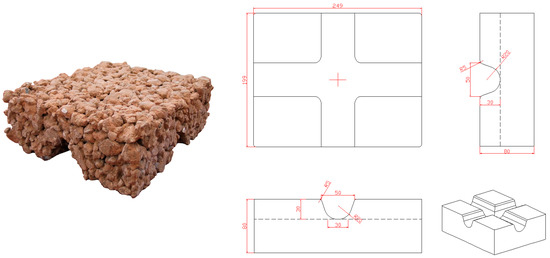
Figure 7.
Design and geometry of porous vegetation red clay green roof blocks (Unit: mm).
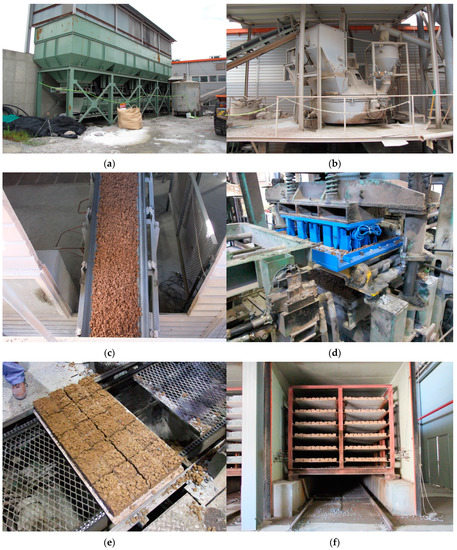
Figure 8.
Manufacturing process of porous vegetation red clay green roof blocks. (a) Material supply; (b) mixing; (c) mixing materials transport; (d) forming; (e) product; (f) curing.
4.2. Field Application
For planning roof vegetation, the scale of vegetation should be determined by checking the structural safety of buildings where the vegetation is installed. This is because lightweight vegetation does not cause serious problems in the construction of roof vegetation, but the installation of heavyweight vegetation or a biotop often requires structural reinforcements to be built. The most serious problem in roof vegetation is soil, which accounts for over 70% of the entire load. Accordingly, the type and depth of soil have a great influence on structures. After reviewing the structure and safety, an initial design with an appropriate mix of low-management lightweight-type and high-management heavyweight-type soils was selected, depending on the maintenance and management functionality of target spaces and users’ demands. The position of rainwater tanks was selected for river discharge. A planting plan was decided in consideration of the loads of soil and green roof vegetation blocks during vegetation using the initial design. Plants were selected with a height as small as possible, with limited aboveground and underground growth, and with strong drought resistance, light resistance, and cold resistance. A planting plan was decided by considering the esthetics of the scenery (Figure 9). Also, Figure 10 shows the photo of housing for porous vegetation red clay green roof concrete blocks application. Grass was used for planting in this study. To compare the results, construction of the green roof vegetation blocks was conducted at the same time as that using the general roof vegetation (drain board + nonwoven fabric installation method) construction method (Figure 11). The waterproof layer sheet was installed and base work was conducted on the roof. The waterproof layer sheet is made of high quality recycled polystyrene with dimensions of 1 m × 1.5 m and thickness of 10 mm. The weight is 1.2 kg/panel, and fresh water and drainage capacity are 3.0 L/m2 and 6.0 L/m2, respectively. No insulation was used. The root barriers and waterproof layers were installed, followed by the green roof vegetation blocks (thickness: 80 mm) or drain board (thickness: 10 mm) + nonwoven fabric (thickness: 2 mm). After pouring lightweight soil over the green roof vegetation blocks or drain board + nonwoven fabric, grass was planted. The depth of the lightweight soil was 188 mm (drain board + nonwoven fabric), and the green roof vegetation blocks (80 mm) were installed at 120 mm. That is, the total thickness was fixed at 200 mm. Lightweight soils were lightweight artificial soils that were processed into a form suitable for plant growth with expanded pearlite calcined at high temperatures above 1100 °C. The permeability coefficient of artificial soil is more than 3.33 mm/min, the effective water content is more than 40%, the unit volume weight is 0.08~0.12 kg/L, and the thermal conductivity is 0.064 W/mK or less. Figure 12a,b shows the rooftop before and after the green roof (after 10 months).
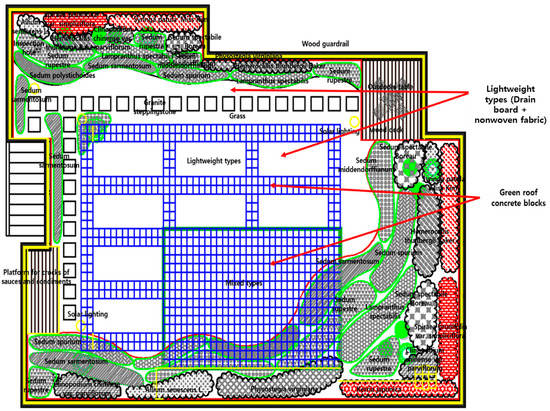
Figure 9.
Design of porous vegetation red clay green roof blocks installation and planting.
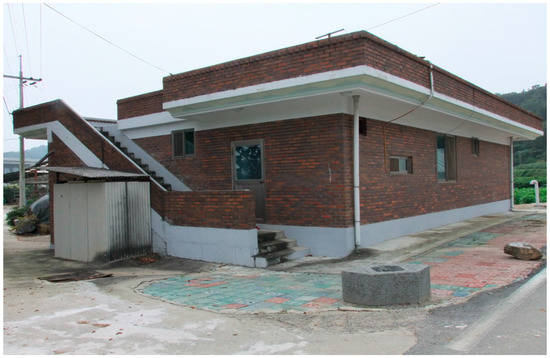
Figure 10.
Photo of housing for porous vegetation red clay green roof concrete blocks application.
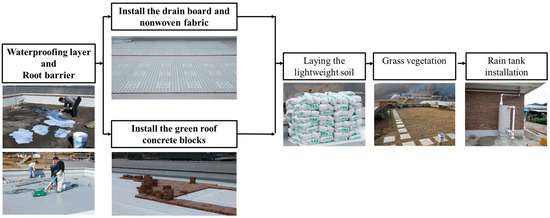
Figure 11.
Construction method of green roof.
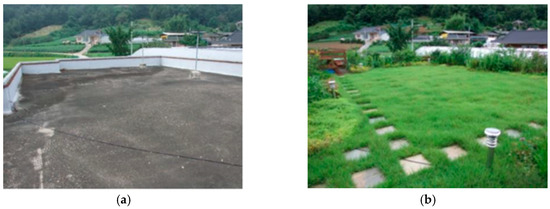
Figure 12.
Photo of roof before and after green roof construction. (a) Before green roof; (b) 10 months after green roof.
4.3. Amount of Rainwater after Rooftop Greening
To measure the amount of obtained water due to rainfall in the roof vegetation system accurately, a rainfall meter was installed after the roof vegetation to measure daily rainfall (Figure 13). The total rainfall for 2 days, from 16 to 17 March 2012, was 4.5 mm, and the total area of roof vegetation was 141.21 m2. Accordingly, the total amount of rain on the area covered with roof vegetation was calculated to be 635 L. Rainwater tanks with a collection capacity of 480 L were installed at point A and point B. The rainwater tank installed at point A collected rain through the roof vegetation using the green roof vegetation blocks, and the tank at point B collected rain through the roof vegetation installed by applying drainage pipes and lightweight soil. The amount of water collected in the water tanks for 2 days was 334.41 L, which is 53% of the total rainfall for these 2 days. After application of the roof vegetation technology developed in this study, it was possible to secure 0.53 L of water per 1 m2 for rainfall of 1 mm. In addition, since the total rainfall for 2 days, from 22 to 23 March 2012, was 19 mm, the total amount of water collected at both point A and point B was 480.8 L (Table 7).
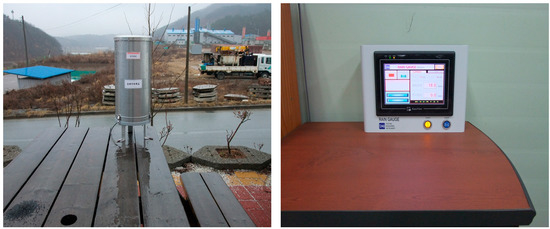
Figure 13.
Photo of rainfall measurement installation.

Table 7.
Rainwater collection amount for rainfall of 4.5 mm (16–17 March 2012).
4.4. Water Quality Analysis
After the application of roof vegetation, the effluent flows down to rivers and the water is used in agriculture. Thus, in this study, Class 4 of the River-life Environmental Standard for the Availability of Agricultural Water was selected as the quality standard for the effluents; the details of this standard are provided in Table 8. The water quality analysis results for the effluents after application of roof vegetation are given in Table 9. In the case of SS (Suspended Solid), point A showed 6 mg/L and point B 2.4 mg/L, both of which satisfied the standard of 100 mg/L. BOD (Biochemical Oxygen Demand), COD (Chemical Oxygen Demand), and DO (Dissolved Oxygen) values also satisfied the standards, and pH was found to be neutral. Also, the pH values at A and B showed no significant differences. In the case of total phosphorus, however, point A satisfied the standard of 0.3 mg/L, but point B showed 1.664 mg/L, which is much higher than the standard. After the application of roof vegetation, the effluents that flowed to point B, the zone (drain board + nonwoven fabric installation method) of lightweight soil without green roof blocks, showed a high index of total phosphorus due to the organics contained in the lightweight soil. At point A, the zone where the green roof vegetation blocks were applied, the total phosphorus was 0.065 mg/L, which satisfied the standard of 0.3 mg/L.

Table 8.
Living rivers environmental standards [24].

Table 9.
Water quality test results.
5. Conclusions
Green roof vegetation blocks were manufactured for the restoration of ecological systems through roof vegetation by mixing blast furnace slag aggregates, a hydrophilic fiber, blast furnace slag fine powder, cement, and red clay. They were applied to ecological restoration sites to evaluate the performance. The test results are summarized as follows:
- (1)
- The physical and mechanical properties of the porous red clay roof vegetation blocks for roof vegetation were evaluated, and they were found to have a compressive strength above 8 MPa, void ratio above 20%, and a unit mass 2.0 kg/cm3 cm3 or below. The test results show that the mix satisfying the target performance had the following composition: cement = 128.95 kg/m3, BFS = 96.75 kg/m3, red clay = 96.75 kg/m3, water = 81.50 kg/m3, BFS agg. = 1450 kg/m3, and PVA fiber = 1.26 kg/m3.
- (2)
- To investigate the amount of water obtained through rainfall, a rainfall meter was installed after the application of roof vegetation to measure daily rainfall. The calculation results of the amount of water secured show that, in the case of rainfall of 1 mm, it is possible to secure about 0.53 L of water per 1 m2.
- (3)
- The effluent quality results after the application of roof vegetation show that the water quality satisfied Class 4 of the River-life Environmental Standard for Availability of Agricultural Water.
Acknowledgments
This research was supported by the basic science research program through the national research foundation of Korea (NRF) founded by ministry of education (NRF-2016R1D1A3A03918587). Also, this work was supported by Korea Institute of Planning and Evaluation for Technology in Food, Agriculture, Forestry and Fisheries (IPET) through Agri-Bio industry Technology Development Program, funded by Ministry of Agriculture, Food and Rural Affairs (MAFRA) (316034-3), and this research was supported by a grant (15SCIP-B105148-01) from the Construction Technology Research Program funded by the Ministry of Land, Infrastructure, and Transport of the Korean government.
Author Contributions
Hwang-He Kim conceived and designed the experiments; Chun-Soo Kim performed the experiments; Ji-Hong Jeon and Seung-Kee Lee reviewed the references and provided useful comments; Chan-Gi Park analyzed the data and wrote the paper. All authors have read and approved the final manuscript.
Conflicts of Interest
The authors declare no conflict of interest.
References
- Ahn, G.Y.; Han, S.W.; Lee, E.H. The analysis of instantaneous uptake and evapotranspiration of herbaceous plants for artificial roof greening. Korean J. Environ. Ecol. 2011, 25, 91–100. [Google Scholar]
- Cho, H.H.; Son, H.J.; Kang, T.H. Hot tolerance assessment of sedum for extensive green roof system. J. Korean Inst. Landsc. Archit. 2012, 40, 180–189. [Google Scholar]
- Choi, H.Y.; Kim, M.H.; Hwang, H.Z.; Choi, S.W. Experimental study on the properties of concrete by the kinds of admixture and the replacement ratios of activated Hwangtoh. Korea Concr. Inst. 2001, 13, 123–129. [Google Scholar]
- Kim, H.H.; Kang, S.M.; Park, J.S.; Park, S.W.; Jeon, J.H.; Lee, J.H.; Cha, S.S.; Park, C.G. Performance evaluation of porous Hwang-toh concrete using blast furnace slag cement. J. Korean Soc. Agric. Eng. 2010, 52, 9–17. [Google Scholar] [CrossRef]
- Kim, S.C.; Lee, H.J.; Park, B.J. Heat budget analysis of light thin layer green roof planted with Zoysia japonica. J. Korean Inst. Landsc. Archit. 2012, 40, 190–197. [Google Scholar] [CrossRef]
- Korea Environment Institute. Impacts of Green Spaces on Air Quality; Korea Environment Institute: Seoul, Korea, 2007.
- Lee, C.W.; Kim, S.B.; Mun, H.S. A study on the analysis of temperature reduction effect by the types of the green roof. J. Korean Hous. Assoc. 2011, 22, 25–33. [Google Scholar] [CrossRef]
- Lee, S.T.; Kim, J.S. Temperature changes of indoor and outdoor by grass planting block in planting of roof area. Korean J. Environ. Restor. Technol. 2004, 7, 54–60. [Google Scholar]
- Oh, R.O.; Jeon, J.H.; Kim, C.S.; Kim, H.H.; Kwon, W.S. Physical Mechanical and Temperature Properties of Fiber Reinforced Porous Green Roof Hwang-toh Concrete. J. Korean Soc. Agric. Eng. 2013, 55, 65–72. [Google Scholar]
- Seoul Metropolitan Government. Manual of Management and Construction Green Roof System; Seoul Metropolitan Government: Seoul, Korea, 2007.
- Yang, B.E. Green roof technology of Korea. Korean J. Environ. Restor. Technol. 2004, 7, 1–7. [Google Scholar]
- Sung, C.Y.; Kim, Y.I. Experimental study on pH reduction by neutralization treatment and curing methods of porous concrete for planting. J. Korean Soc. Agric. Eng. 2002, 44, 99–106. [Google Scholar]
- Sung, C.Y.; Kim, Y.I. Experimental study on development of plantable concrete block using rice straw ash and application for inclined plane. J. Korean Soc. Agric. Eng. 2003, 45, 107–114. [Google Scholar]
- Youn, J.N.; Sung, C.Y.; Kim, Y.I. Physical and mechanical properties of porous concrete using waste activated carbon. J. Korean Soc. Agric. Eng. 2009, 51, 21–27. [Google Scholar] [CrossRef]
- Kim, H.H.; Kim, C.S.; Jeon, J.H.; Park, C.G. Effects on the Physical and Mechanical Properties of Porous Concrete for Plant Growth of Blast Furnace Slag, Natural Jute Fiber, and Styrene Butadiene Latex Using a Dry Mixing Manufacturing Process. Materials 2016, 9, 84. [Google Scholar] [CrossRef]
- Kim, H.H.; Park, C.G. Plant Growth and Water Purification of Porous Vegetation Concrete Formed of Blast Furnace Slag, Natural Jute Fiber and Styrene Butadiene Latex. Sustainability 2016, 8, 386. [Google Scholar] [CrossRef]
- Kim, H.H.; Park, C.G. Performance Evaluation and Field Application of Porous Vegetation Concrete Made with By-Product Materials for Ecological Restoration Projects. Sustainability 2016, 8, 294. [Google Scholar] [CrossRef]
- Lee, J.H.; Park, C.G. Effect of blast furnace slag, hwang-toh and reinforcing fibers on the physical and mechanical properties of porous concrete using blast furnace slag coarse aggregate. J. Korean Soc. Agric. Eng. 2010, 52, 53–60. [Google Scholar] [CrossRef]
- Nature and Environment Co., Ltd. Porous Vegetation Block Manufacturing Technology Using Blast Furnace Slag Cement, Hwang-toh and Recycled Aggregate; NET No. 0078; Ministry of Science and Technology: Seoul, Korea, 2006.
- Lee, J.H.; Park, J.S.; Park, C.G. Effect of Reinforcing Fiber on Mechanical Properties and Chemical Resistance of Porous Concrete with Hwang-toh. J. Korean Soc. Agric. Eng. 2011, 31, 105–113. [Google Scholar]
- Neville, A.M. Properties of Concrete; Longman: Harlow, UK, 1995. [Google Scholar]
- Standard Test Method for Unit Weight of Structural Light Weight Concrete, KS F 2462; Korea Standard Service Network: Seoul, Korea, 2016.
- Standard Test Method for Compressive Strength of Concrete, KS F 2405; Korea Standard Service Network: Seoul, Korea, 2010.
- Korea Ministry of Environment. River Living Environment Standard Enforcement Decree of the Framework Act on Environmental Policy, Environmental Standards Article 2, River and Lake Water Quality Standard; Korea Ministry of Environment: Seoul, Korea, 2013.
© 2017 by the authors. Licensee MDPI, Basel, Switzerland. This article is an open access article distributed under the terms and conditions of the Creative Commons Attribution (CC BY) license ( http://creativecommons.org/licenses/by/4.0/).